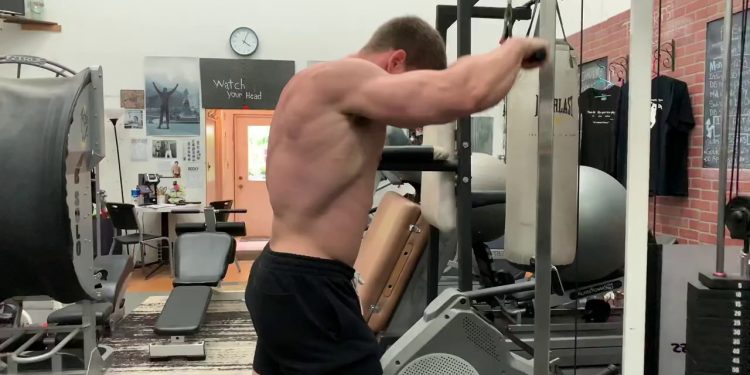Cable Pullover
When you perform a cable pullover, you are working the muscles in the Lats, which are a major muscle group. The exercise also targets all three heads of the triceps. A cable pullover is done with a straight-bar attachment to a cable machine. This article will help you perform this exercise correctly. We’ll also explain how to adjust the weight and the reps so that you can achieve the maximum benefit.
Lats are the main muscle group worked by a cable pullover
A cable pullover is a great exercise for working the lats. While the cable pullover looks like an arm exercise, the muscles are actually working primarily in the back through shoulder extension. The exercise will work the lats by performing shoulder extension, horizontal pulling, and lateral flexion. Performing the cable pullover regularly will help you build strong, lean lats.
When performing a cable pullover, it is important to keep your arms straight. This will help you perform the movement efficiently and achieve the greatest results. If you bend your elbows too much, you’ll be causing less tension in your lats. Try to keep them bent but not locked completely to avoid tension retention. This will ensure that you work your lats and engage with the handles.
While this exercise is very effective in working the lats, a few key things should be kept in mind when performing this exercise. Firstly, don’t use too heavy weight. Too much weight will put more stress on the shoulders and ancillary muscle groups and cause back pain. If you’re using a cable pullover to strengthen your lats, keep the weight light.
Cable pullovers also work the triceps brachii. The triceps brachii muscle is located on the back of the upper arm. The long head of the triceps crosses the shoulder joint and plays a part in shoulder extension. Another muscle group that is also worked by cable pullovers is the rectus abdominis. The rectus abdominis is responsible for maintaining the lumbar spine while performing the exercise. When performing the exercise, it is necessary to hold the handle with an overhand grip.
It is an isolation exercise
The cable pullover is an excellent lat-specific isolation exercise. It is important to be very strong in the core, though, since standing cable pullovers can cause hyperextension of the spine. Lie-down cable pullovers are better for your lower back. Do not use too heavy a weight, and use a high rep range. When performing cable pullovers, do so with a straight-bar attachment.
The most important thing to keep in mind while performing the cable pullover is to keep your elbows straight. This will allow you to get an effective shoulder contraction. Avoid bending your elbows to accommodate a downward movement, as this can result in tightening your shoulders. Also, try not to lock your elbows out, since locking them out can train your shoulders more than you want. If you are unable to do this, you should not perform this exercise properly.
The cable pullover is a great isolation exercise for lats, as it works your lats while working the rest of your back. You should focus on shoulder extension-based back movements, but don’t overlook vertical and horizontal pulling as they are equally important. The goal is to develop a stronger back, which will make it more effective when it comes to sports and everyday activities. It will also make you stronger in your shoulders, making it easier to perform other exercises.
The cable pullover is a great exercise to build chest muscles, but it also helps your overall health. It works your pectoral muscles, which make up the bulk of your chest. The pectoralis major and minor work in tandem to stabilize the shoulder blade. These two muscles also work with supporting muscles to initiate shoulder movements. They are also commonly known as “the lat’s little helper.”
It is performed by all three tricep heads
The cable pullover is a common exercise that isolates and activates the lats, an area of muscle that is very important for improving a person’s physique and performance. This exercise engages all three tricep heads and works the long head of the triceps, which is the fleshy part of the back of the upper arm. All three heads work together to help stabilize the shoulder joint and facilitate movement with the upper arm.
The deltoid is a large muscle located in the shoulder. It is divided into three parts: the anterior, lateral, and posterior. The anterior head helps reach the arm forward, the lateral head helps abduct the arm away from the side, and the posterior head extends the arm horizontally. During the cable pullover, the anterior and lateral deltoid receive stimulation from the cable. The posterior head is responsible for pulling the cable towards the body.
A cable pullover is a great exercise to strengthen your upper back while building endurance. For best results, perform 2-3 sets of twelve to fifteen reps. For building muscle mass, use a heavier weight and longer handles. Rest times between sets should be around two minutes. It is important to find the correct weight and height for the cable pullover, as otherwise, you can injure your shoulders.
The cable pullover works all three tricep heads, but is an excellent isolation exercise for lats. It also works your back, through shoulder extension. The lats are important for developing overall back strength, and cable pullovers are an excellent way to develop lats and develop core strength. There are some additional benefits to this exercise. The weight of the cable pullover can be easily adjusted to suit different levels of fitness.
It is performed with a straight-bar attachment to a cable machine
The cable pullover is a great upper body workout that is incredibly effective at strengthening the pectoral muscles. It is best performed by alternating between two sets of 12-15 reps and three sets of eight-10 reps. While the rest period between sets can vary, a good rule of thumb is to aim for at least one minute, but no more. In addition, it is important to remember to maintain good posture when performing this exercise.
To begin, place a bar attachment with a straight-bar on the cable machine. Attach the cable stirrup handles to a medium-high pulley below the level of your head. To perform the cable pullover, hold the handle with your right hand, elbow bent, and palm upward. Step forward with your right foot and use your other hand to add tension. Next, extend your right arm, bringing the handle to shoulder height. Then, let it return to its starting position. Repeat with the left arm.
If you prefer to perform cable pullovers on a bench or stability ball, you must adjust the attachment slightly. Ensure that the straight-bar attachment is higher than your head when you’re lying on it. Once you’ve mastered the proper positioning, make sure that your upper back is comfortable and your shoulder blades are not too far above it. During the entire exercise, you should focus on the lats and not the chest.
In order to perform a cable pullover, you must ensure that you maintain a proper posture when pulling the bar. While extending your arms, keep your elbows slightly bent and keep your shoulders straight. Your elbows should be positioned in line with your hips to ensure proper shoulder contraction. The bar will not come up by itself; you need to keep them locked out.
It is performed with a resistance band
The cable pullover is a great exercise for building upper body endurance. Ideally, you should perform two to three sets of twelve to fifteen reps. However, you can increase the intensity of the exercise by performing a few more sets with slightly varying lengths of rope. The rest time for endurance is typically in the 30 to one minute range, while for building muscle, it can be as long as two minutes.
The cable pullover works both the lats and triceps. Activating and isolating these muscles helps increase your strength and reduce the risk of injury. This exercise works the long head of the triceps, which is the flesh part on the back of the upper arm. It also helps develop stability and balance. A resistance band is necessary for performing the exercise correctly. To prevent injury, it is important to do a warm-up before the workout.
The cable pullover can be performed in both upright and supine positions. Some people like to perform it on a flat bench or stability ball. Regardless of the position, you should focus on keeping your elbows straight during the entire exercise. Keeping your arms straight will help ensure you achieve effective contractions of the lats and shoulders. Similarly, keeping your elbows flexed will accommodate downward movement while locking your elbows out will create more tension in your arms.
While it is difficult to adapt traditional exercises when a gym is closed, using a resistance band is an ideal way to strengthen the muscles in the back. The band acts as a constant resistance throughout the movement, which allows you to achieve the desired results without stressing your joints. If you’re looking for a great workout, cable pullovers are a great choice. So get out there and start working out with a resistance band today!


















